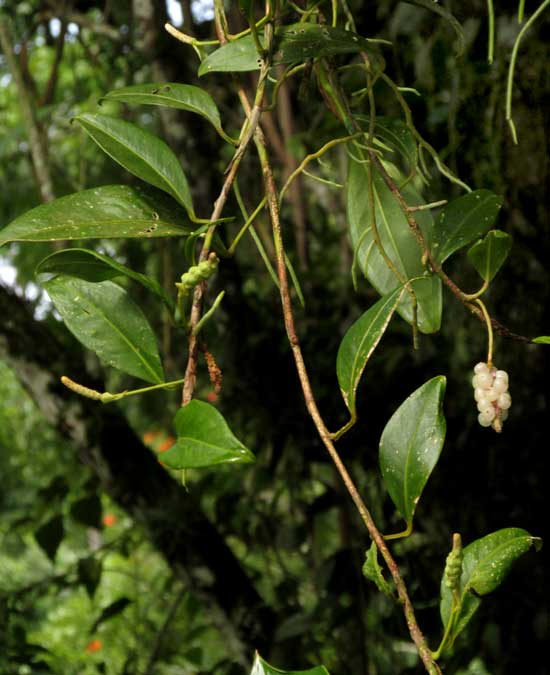Excerpts from Jim Conrad's
Naturalist Newsletter
from the December 14, 2018 Newsletter with notes from a camping trip into Chiapas, the southermost state of MÉXICO
PEARL ANTHURIUM
Last October 3rd when I was camping near Palenque Ruins in Chiapas, at the woods edge a vine dangled from branches of a tall tree, as seen below:

The dangling cluster of waxy looking, pea-sized items at the image's right is what had caught my eye. Searching along the stem for other such clusters I found none, but in the above picture you can see several slender spikelike things issuing from the stem's leaf axils. One of them is shown close-up below:

Seeing that, I knew we had an aroid, a member of the big, mostly tropical Arum Family, the Araceae. If you know North America's famous spring wildflower Jack-in-the-Pulpit, in the above picture you'll recognize the white colored Jack, though his "pulpit," or spathe, instead of mostly folding around and over him, directs back toward the stem. So, what kind of aroid is this?
Mostly by noting that the leaves did not issue milky sap when torn at the edges, that the venation was netted, and that the spathe was backward-pointing, it became clear that this was a member of the big genus Anthurium. Our plant shares some features with another big aroid genus, Philodendron, except that the veins in philodendron species parallel one another, any secondary veins not curving to meet one another, while in Anthurium they do, and so are "netted."
Knowing that we had an Anthurium producing clusters of pearly fruits, it was easy to determine that we had ANTHURIUM SCANDANS, distributed from Mexico south to Venezuela in northern South America. Two subspecies are recognized, and ours is the typical one, Anthurium scandens ssp. scandens. One English name it goes by is Pearl Anthurium. Its clusters of white fruits are pretty enough to cause the species to be planted in tropical gardens.
Last week we profiled the Mistletoe Cactus that at this same time was issuing white, pea-sized, waxy-looking fruits similar to these, though those fruits appeared at the ends of dangling stems. I wonder whether these two unrelated species might have undergone convergent evolution? Maybe at first they each independently evolved small, white fruits because for certain fruit-eating, seed dispersing animals such fruits are easy to see and easy to eat. Over time, both species may have further evolved their fruits to the same pea-size dimension, helping one another teach their commonly held fruit-eaters that these pea-sized white fruits were good. Just a guess, but probably a good one.